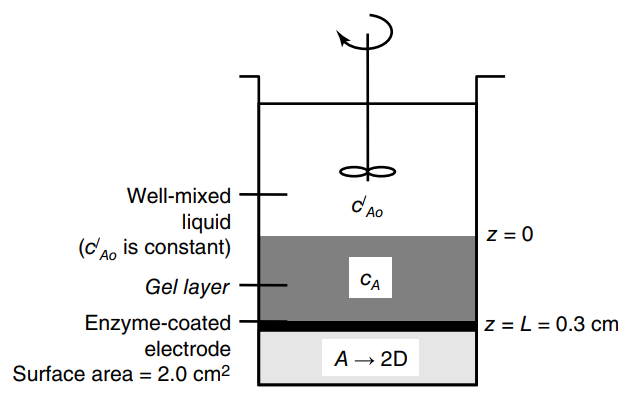Question:
Consider the biosensor device shown in the figure in the next column. The biosensor is designed to measure the concentration of solute A in the well-mixed liquid phase. At the base of the device is an electrode of surface area 2.0 cm
2. The electrode is coated with an enzyme that catalyzes the reaction A †’ 2D. When solute A reacts to product D, product D is detected by the electrode, enabling for direct measurement of the flux of product D, which at steady state can be used to determine the concentration of A in the bulk liquid. The rate of reaction of A at the enzyme surface is rapid relative to the rate of diffusion of A down to the surface. Directly above the enzyme-coated electrode is a gel layer of 0.30 cm thickness that serves as a diffusion barrier for solute A and protects the enzyme. The gel layer is designed to make the flux of A down to the enzyme-coated surface diffusion limited. The effective diffusion coefficient of solute A in this gel layer is D
Ae= 4.0 × 10
-7cm
2/s at 20°C. Above the gel layer is a well-mixed liquid containing a constant concentration of solute A, c'
Ao. The solubility of solute A in the liquid differs from the solubility of A in the gel layer. Specifically, the equilibrium solubility of A in the liquid layer (c'
A) is related to the solubility of A in the gel layer (c
A) by c'
A= K · c
A, with equilibrium partitioning constant K 0.8 cm
3gel/cm
3liquid. The process is considered very dilute, and the total molar concentration of the gel layer is unknown. The concentration of product D in the well mixed liquid is very small so that c
Do‰ˆ 0. At 20°C, the electrode measures that the formation of product D is equal to 3.6 × l0
-5mmole D/h. What is the concentration of solute A in the bulk well-mixed liquid phase, c'
Ao, in units of mmole/cm
3?

Transcribed Image Text:
Well-mixed d'Ao liquid (C'Ao is constant) CA Gel layer z = L = 0.3 cm Enzyme-coated electrode A → 2D Surface area = 2.0 cm2








